|
1.
CENTRAL/ WEST AFRICA
Prices sustained by supply-driven market
Log prices remained largely unchanged by mid August as the summer holiday continued, although demand from
China and India remained very active. There was also a firm demand for selected, favourite species from
European buyers. The changes in the past year that have curtailed global log supply and driven the market by
supply rather than demand had kept sustaining prices. The trend is for stable and upward pricing as buyers look
to purchase beyond the readily available volumes of the more valued species. The firm price trend is reinforced
by the wider spread of market opportunities in Asia (India and China), South Africa (seeking long term
supply of sawn lumber), Italy (where demand is returning back to a growth cycle) and Europe (where importers
plan purchases to carry through the fourth quarter).
Exporters upbeat on autumn demand prospects
Prices for sawn lumber prices have also remained stable and unchanged. Existing contract commitments are
keeping sawmills fully occupied. At this stage, exporters appear satisfied with the prospects for autumn demand
for Europe. Some importers have contracts for their favourite species and specifications running right through
the fourth quarter. Demand from the Netherlands and
Germany have improved sufficiently for exporters to feel confident that prices will remain stable and responding,
as usual, within fairly narrow limits to the normal fluctuations in demand for particular species.
IFO generates energy from wood waste in Congo
Sawmill IFO, a subsidiary of the German Danzer Group in northern Republic of Congo, has
activated a new steam generator fuelled by wood waste products from its sawmill. IFO expected to reduce its annual CO2
emissions by some 3,300 tons per year and its dependence on diesel fuel. The new steam generator
generates 700 kilovolt amperes.
Danzer Group, the world's largest manufacturer of hardwood veneers, has another subsidiary
(SIFORCO), which operates a veneer plant and sawmill in the Democratic Republic of Congo. IFO and SIFORCO
manage 3.2 million ha of forest concessions. Certification in accordance with ISO standard 14001 by
independent auditors is expected by 2007 for IFO and at the end of 2009 for SIFORCO.
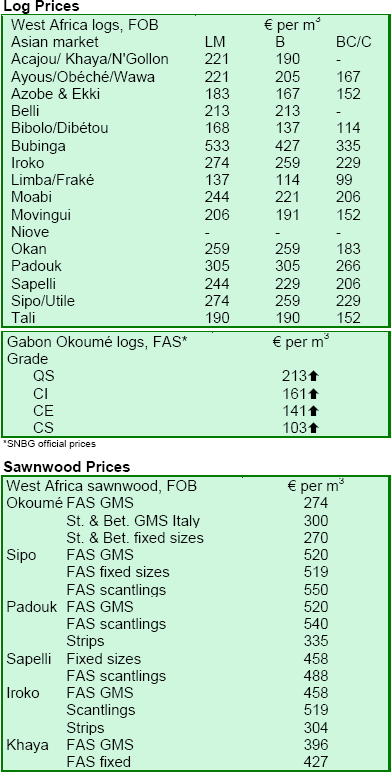
2. GHANA
Prices remained largely stable as markets rest
With few exceptions, prices had been generally stable during the second quarter of 2006 as markets remained
quiet. Prices for odum sawnwood AD, which were stable in the first quarter, dropped by euro20-30 compared with the
TIDD Guiding Selling Price (GSP) of euro640 per m3. The
demand for this species by Ireland, its main importer, declined significantly. Buyers were even securing
contracts at cheaper prices of about euro600 per m3 in Cameroon and Côte
d'Ivoire.
Export of niangon boules, which showed signs of recovery in the last quarter of 2005, retreated through the
first half of 2006. However, AD boules prices remained firm between euro490 and euro500 per m3. About 70% of the boules contracts submitted to TIDD by Samartex Timber
& Plywood Ltd. were with France and Italy.
Ghanaian traders increased exports to West Africa in the second quarter of the year, particularly to Nigeria. While
USA imported 1,050 m3 of plywood, Nigeria alone imported 22,256 m3. Almost all plywood contracts
approved for Nigerian buyers achieved the TIDD GSP.
FC tightens conditions for contract approvals
In general, there was a quiet atmosphere in the processing and approval of contracts during the second
quarter of 2006. This was partly due to the summer holidays in Europe and the stringent measures adopted by
the Forestry Commission (FC) in June to control illegal felling by making it conditional for timber exporters to
support contract applications with approved yields before
processing. A total number of 952 contracts were submitted for processing, down 12.3% from the previous
quarter. About 80% of contracts approved during the last month of the quarter under review were mostly submitted
by timber companies owning forest concessions that could support most of their timber contract applications
with approved yield.
The volume of teak contracts approved (notably for the Indian market) declined drastically from 21,850 m3 to
6,900 m3 during the quarter under review. The decline was mainly attributed to the difficulty faced by teak
exporters in securing genuine source of raw materials, a conditionality before any contract could be approved by
TIDD.
General Development Company Ltd (GDC), a timber firm based in Takoradi, was given approval to export
industrial boules manufactured from lesser used species (LUS) such as yaya,
ananta, duabankye, berlinia and potrodom. The approval might be extended to all
exporters in the near future. The TIDD approved a GDC contract of 80 m3 of industrial boules at $250 per m3. The
price might be reviewed by the Contract & Permit Department depending on the market response to the
species.
Timber trade exports slide in the first half of 2006
According to the Timber Industry Development Division (TIDD) of the Forestry Commission, Ghana¡¯s wood trade
exports fell 5.1% to 217,590 m3 (down 4.8% to €84.9 million) in the first half of 2006, compared with the same
period in 2005. The decline was due to low export volumes of all products, except plywood,
parquet/flooring and other processed wood products.
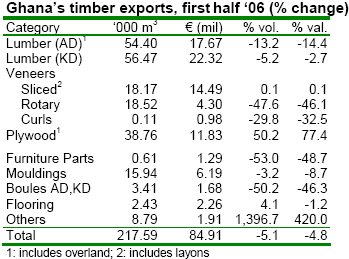
Exports of secondary processed wood products
(SPWPs) totaled 31,180 m3 (€13.33 million) in the period under review, accounting for 14.3% (15.7% of the value) of the
total exports. AD and KD lumber altogether accounted for 51% of the total export volume for the period. The
export volume of these products declined 13% and 5%, respectively, arising from the effect of the raining season
on log harvesting.
Exports of rotary veneer plunged 48% to 18,520 m3. The USA accounted for 66% of this volume. In contrast,
plywood exports soared 50% to 38,758 m3, boosted by demand from West Africa.
Overland exports of plywood accounted for 72% of these exports with sea exports
accounting for the balance. During the second quarter of 2006, 110 permits were granted to 12 companies to
export plywood and lumber by road to Senegal, Burkina Faso, Mali, Nigeria, Niger, Togo and Benin.
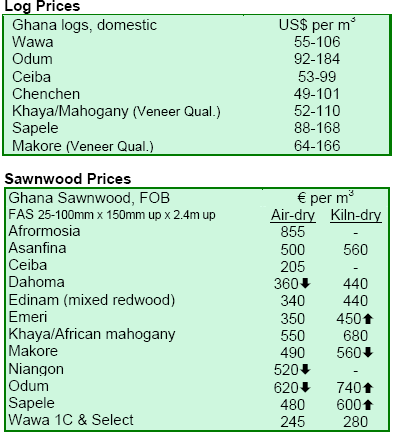

3.
MALAYSIA
Malaysia loosens ban on finger-jointed rubberwood
The Malaysian Government has relaxed the export ban on finger-jointed rough sawn rubberwood following
appeals from the upstream industry. On July 11, the Plantation Industries and Commodities Ministry had
imposed an export ban on four categories of fingerjointed rubberwood planks that would come into effect
on 11 August 2006 (see TTM 11:13).
While the Malaysian Furniture Entrepreneurs Association and Malaysian Furniture Industry Council expressed support
for the ban, the Malaysian Rubberwood Trade and Industry Association appealed against it, arguing it had
caused the tender price for the felling of rubber trees to plunge, affecting their business. To balance the opposing
needs of upstream and downstream players of the rubberwood industry, the government has decided to
impose the export ban on only two categories of roughly-sawn finger-jointed rubberwood, instead of the
original four. The export ban is now imposed on finger-jointed rubberwood of 3 1/2 inches of thickness or
more and on portions of finger-jointed rubberwood shorter than one foot.
The government will review the ruling on 11 February 2007 and tighten the export ban again if the supply of
rubberwood to local furniture manufacturers does not improve.
Plywood players favour gradual rise in prices
Some major players in the plywood sector are in favour of gradual rise in prices instead of a sharp increase.
According to them, a sharp increase would cause closed plywood factories to re-open which could lead to
over-capacity detrimental to the industry. Overall, prices for most Malaysian timber products remain steady.
Exporters pin hopes on post-typhoon reconstruction
Malaysian timber exporters, especially in the panel products sector, are hopeful that post-typhoon Saomai
reconstruction projects in China will help lift the Malaysian timber industry further. Typhoon Saomai, the
strongest to hit China in over half a century, caused almost $2 billion in economic losses.


4.
INDONESIA
Processed products prices buck bearish trend
Prices of Indonesian timber products continue to be bearish or flat. However, prices of some value-added
products, such as plywood and panel-products, remain steady on the back of keen orders from Japan, China and
India.
Indonesia seeks Korean investment in timber estates
The Indonesian Minister of Forestry, MS Kaban, met potential South Korean investors in Seoul, early August,
to encourage them to do business in Indonesia and speed up development in 8 million ha of Indonesia¡¯s timber
estate areas. The Minister had expressed hope that South Korean investors would also help to develop 500,000 ha
of timber estate areas currently managed by the Korean Korindo Group.
The Indonesian government was prepared to extend the concession period up to 100 years in these timber areas in
order to encourage private sector participation.
GSP review may hit Indonesian plywood
The Office of the US Trade Representative (USTR) announced 8 August that it was initiating a review of the
eligibility of certain GSP beneficiary countries and existing competitive need limitation (CNL) waivers, the
International Wood Products Association (IWPA) informed. USTR was seeking written comments on
whether to limit, suspend or completely withdraw GSP benefits from 13 of the program¡¯s largest users:Argentina, Brazil, Croatia, India, Indonesia, Kazakhstan,
Philippines, Romania, Russia, South Africa, Thailand, Turkey and Venezuela.
In addition, USTR was requesting written comments on whether any of the existing CNL waivers should be
terminated. Products from certain countries currently receiving CNL waivers were not subject to the CNL
thresholds ($125 million in 2006) and received unlimited GSP benefits. However, under the GSP statute, the US
President may terminate any waiver if it is no longer warranted due to changed circumstances. The targeted
CNL for wood products is plywood from Indonesia (HTS
Code 4412.13.40, plywood with at least one outer ply of tropical wood). All comments pertaining to this review
must be received by USTR not later than 5 September 2006.

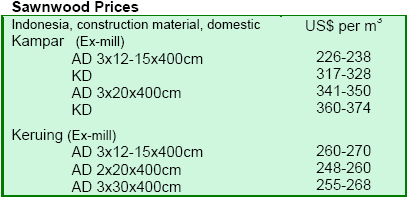
5.
MYANMAR
Speculation sent teak log prices retreating
Speculation on an impending price increase loomed darkly in the Yangon timber market during the second
half of July, casting a disturbing effect on the open tender bidding for grades SG4 and higher. Fewer bidders
participated initially in the bidding, and the tender bidding returned to normal only when MTE confirmed
that there would not be any price increase. Consequently, main tender average prices for these grades were
substantially lower compared with June levels. In contrast, teak log prices for SG5 and below sold by
sealed tender surged further.
Meanwhile, the market for pyinkado and gurjan logs was not very active. After the latest price hike on 10 July,
preference is for pyinkado logs with girth over 7 feet. Buyers have lost interest in logs with smaller girths.

Local sawn teak market remains sluggish
The local sawn teak market remains weak. The lacklustre performance of the Myanmar private wood industry is
attributed to many factors, including the cost and availability of raw materials. Although Myanmar wood
firms also compete in monthly tender sales, the quantities obtained by competitive bidding may not always ensure a
viable business.

6. PAPUA
NEW GUINEA
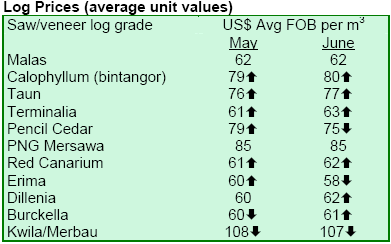

7.
BRAZIL
Elliotis pine faces continued weak demand
The demand for Brazilian elliotis pine plywood has remained subdued in the USA and Europe, according to
Euwid. US demand for softwood plywood from Brazil fell early in the year below previous
year's level and
continued declining through June and July. Similarly, European demand for this product has remained weak
after the expiration of the duty free quota. Consequently, Brazilian suppliers could not offset the decline in
deliveries to the USA. European demand for elliotis pine plywood is expected to recover at the end of August or in
September when customers would place orders against next year's duty free quota.
Prices for elliotis pine plywood have been edging down as a result of the low demand, compounded by a weak
US dollar against the Brazilian currency. Brazilian companies that had specialized in producing US grades
were the most affected. Meanwhile, competition from Chinese products continued to strengthen.
Brazilian producers plan plywood production cuts
Major Brazilian plywood producers would cut plywood production and shipments to the USA in view of low
price levels, Random Lengths informed. Producers would shift to more aggressively serve markets in Mexico and
the Caribbean. Facing the tariffs and a slowing US market, Brazilian producers are increasingly pressured to
ship elsewhere, including Europe. However, with the EU
plywood quota filled for the year, traders indicated that plywood would be shipped to bound warehouses for
storage until January or for coverage of emergency needs.
Solid-wood industry suffers sharp slide in revenue
The revenues of the solid-wood industry of the Amazonas State fell 20% to $7.71 million in the first five months of
2006, compared with the same period of 2005. According to the state's Union of Veneer and Plywood Industries,
IBAMA's delay in the authorization of forest management plans for timber harvesting was the main constraint faced by
the sector. IBAMA authorized only 60 forest management projects up to March 2006. Since then, State authorities
through IPAAM (Environmental Protection Institute of State of Amazon) are responsible for the processes of
licensing management plans. A number of timber processing companies have stopped production. Out of four companies,
one operates at only 25% of its installed capacity.
Plywood exports decline amid falling prices
Plywood exports fell 18% to $326.5 million in the first half of 2006, according to the Secretariat of Foreign Trade
(SECEX). An unfavourable exchange rate and the decline in wood panel prices in the USA and Europe contributed to the poor
performance, according to the Brazilian Association of
Mechanically Processed Timber (ABIMCI). Pine plywood prices fell 15% in the last three months in the USA, with
current average prices at $190 per m³, according to ABIMCI. In Europe, prices slid 5% in the same period as a result of the
summer vacation, to $225 per m³, below production cost of
$240 per m³.
ABIMCI expects recovery of plywood in second half
Although plywood prices were expected to recover in the second semester, ABIMCI said the sector was not likely to
offset the losses accumulated in the first semester due to the unfavourable exchange rate. Nevertheless, tropical plywood
might show some recovery as a result of the reduction in Chinese participation in the international market, pressured by
claims of use of illegally sourced logs. Tropical plywood prices are being traded at an average of $400 per m³, up 21%
in the past two months.
In the domestic market, the main problem faced by plywood companies is high log prices that accounted for about 60% of
plywood production costs. According to ABIMCI, at least 20,000 jobs had been lost in the sector over the past several
months. Exports of mechanically-processed timber, which includes plywood, door, frames, wood flooring and lumber
manufacturers, fell 2.6% to $1.49 billion in the first semester of 2006.
New credit line for the ailing furniture sector
A new credit line amounting to 600 million reais (over $250 million) was announced by the Ministry of Planning to
support the furniture, solid-wood and agricultural machinery and equipment sectors. Furniture producers of the Western
region of Santa Catarina have waited since last year for a positive action from the federal government to help them
overcome the ongoing crisis. The credit line consists of loans from the Workers Aid Fund (FAT) operated by Bank of
Brazil. Analysts consider that the financial cost and period for payment are attractive to furniture producers in need of
financial resources. The government measure is aimed at assisting primarily small and medium-sized
companies.
Over 60% of wood supply to come from plantations
More than 60% of sustainable wood supply in Latin America and the Caribbean (LAC) would come from
planted forests by the year 2020, leaving more natural forests untouched, according to
FAO's Forestry Sector
Outlook Study for Latin America and the Caribbean. Annual potential wood supply from sustainably managed
planted forests would increase from 303 to 480 million m3 while that from natural forests would shrink from 320
to 293 million m3 from 2003 to 2020. The shift from natural forests to planted forests for wood supplies in the
region has been driven by intensive reforestation projects in most countries, led by the private sector and supported
by national programmes. It has also been driven by increasingly restricted access to natural forests and
greater regulation in the management and use of natural resources.
According to the study, planted forests in the region are forecast to increase from 13.1 million ha in 2005 to 17.3
million ha in 2020. In contrast, natural forests are expected to shrink from 924 to 881 million ha during the
same period. The study cites the expansion of agriculture and cattle raising as the main causes of deforestation.
Expected population growth from 520 million in 2004 to 620 million in 2020 and economic growth are likely to
lead to a corresponding increase in the demand of forest products, including fuelwood and charcoal for domestic
and industrial uses, adding further pressure on forest resources. On the other hand, greater environmental
awareness in the region is expected to boost the expansion of protected areas. Protected areas have
increased between 1950 and 2000, from 17.5 million ha to 386 million ha, about 23% of the global protected
areas. FAO said this trend is likely to continue.

8. PERU


9. BOLIVIA
Europe overtakes USA as
Bolivia's largest market
Europe is now the largest market for the Bolivian forest industry, overtaking the USA from the first place. This
was helped by growing chestnut and sawnwood exports.
According to the Bolivian Forestry Chamber (CFB), Europe accounted for 27% of the
country's exports in
2001 and 40% in 2005 ($65 million). Europe absorbed 64% of Bolivia's non-timber product exports (notably
chestnut) and 17% of its timber products. On the other hand, the USA imported 48% of Bolivian timber exports
and 20% of non-timber exports. Six European countries
accounted for 88% of the exports to that continent: UK, Germany, the Netherlands, Spain, France and Italy.
About $51 million of the exports (79%) to Europe were non-timber products.
TracElite proposed for monitoring system in Bolivia
Helveta's TracElite, Intel, the Tropical Forest Trust (TFT), the Nature Conservancy (TNC) and the USAID
have joined forces to provide a new strategy for sustainable forest practices to the Bolivian Forest
Superintendency. TracElite, a timber traceability and supply chain monitoring system, has been proposed as
the tool to monitor illegal logging and the on-going development of sustainable forest management (SFM). A
nationwide deployment is expected if trials are successful in selected pilot locations. TracElite has been used in
Indonesia and Central Africa.
The system employs a mix of satellite communications, mobile wireless-enabled notebooks,
servers, wireless handhelds and RFID tags to form a tracking system that can provide ¡ˇăback to stump¡ˇŔ traceability for logs from
any point in the supply chain. The system can also detect illegal logs entering the supply chain.

10. Guatemala

11.
Guyana

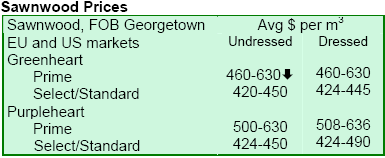
|